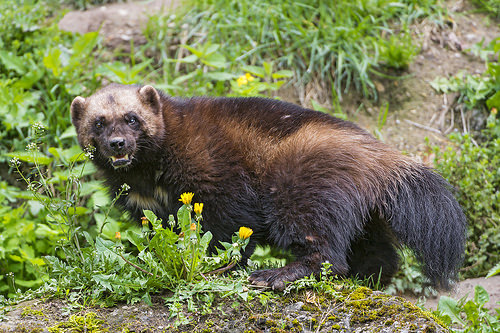Any wolverine you come across may be slightly dangerous.
- Wolverines are mammals found in the northern areas of the Northern Hemisphere, and the largest population can be found in America’s Canada.
- A ‘wolverine’ is also known as a ‘carcajou’, ‘skunk bear’, ‘glutton’ and ‘quickhatch’, while its scientific name is Gulo gulo, and it is from the family Mustelidae, the family of weasels.
- Wolverines look somewhat like a bear, and they have notably lengthy claws and a strong jaw; and the fur is significantly water repellant which is mostly coloured brown and black.
- Wolverine habitats range from alpine tundras to forests of the taiga and subarctic; and they usually live alone.
- Wolverines range from 65 to 107 centimetres (26 to 42 inches) in length, and generally weigh between 9 to 32 kilograms (20 to 71 pounds), and they are the largest species in the weasel family that live on land.
Wolverine
Image courtesy of Tambako the Jaguar/Flickr
- Mammals make up the primary diet of wolverines, and includes rodents, foxes, weasels, moose and deer, and occasionally vegetation, eggs, insects and birds.
- Female wolverines give birth every two or three years around spring, to an average of two or three kits; and the typical lifespan of the animal ranges from 8 to 15 years, and they have been kept successfully in zoos.
- Although classified as least concern, wolverine numbers have been declining, and are threatened from illegal hunting in some areas, as well as loss of habitat.
- Wolverines are notable in both film and literature, particularly as the concept of the Marvel Comic superhero of the same name.
- When threatened or trying to repel fellow competitors, wolverines may excrete an unpleasant smell; and the males have a very large territory that can be 620 square kilometres (240 square miles) or more in area.
Bibliography:
Wolverine, 2013, A-Z Animals, http://a-z-animals.com/animals/wolverine/
Wolverine, 2015, National Geographic, http://animals.nationalgeographic.com.au/animals/mammals/wolverine/
Wolverine, 2015, Wikipedia, http://en.wikipedia.org/wiki/Wolverine







